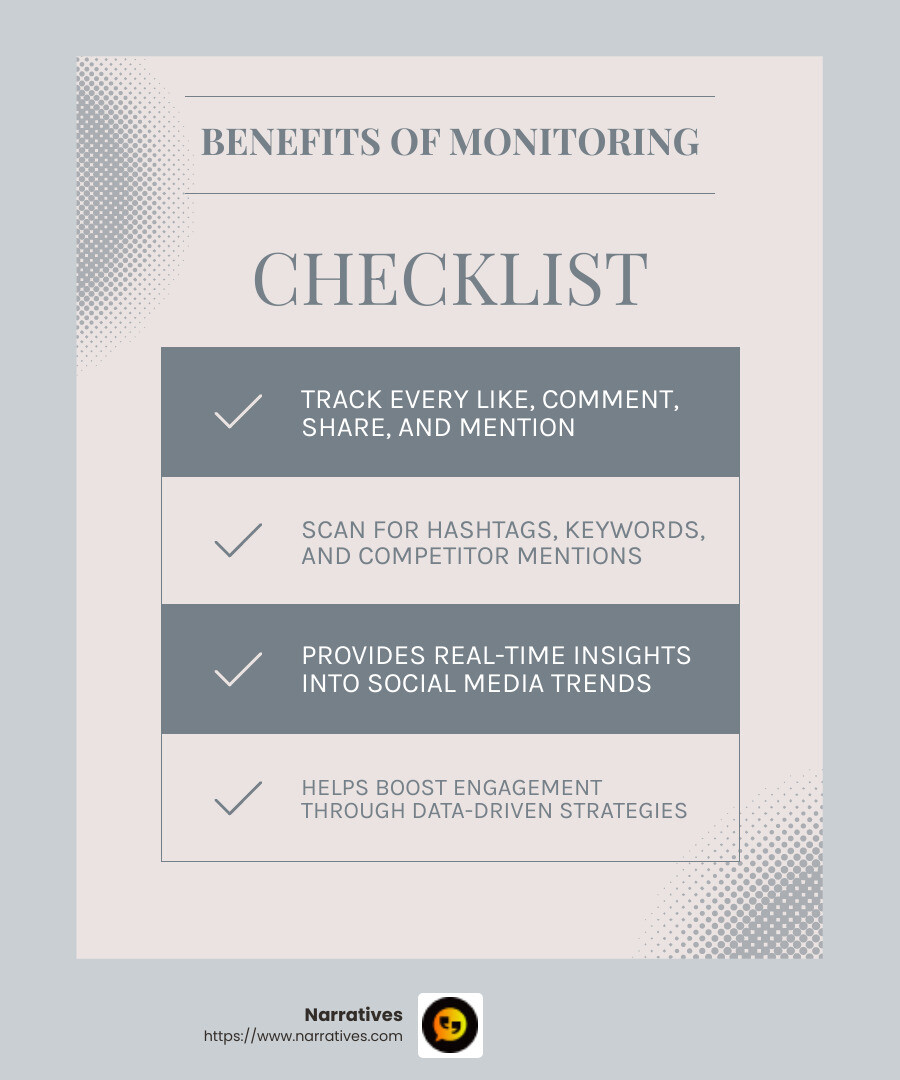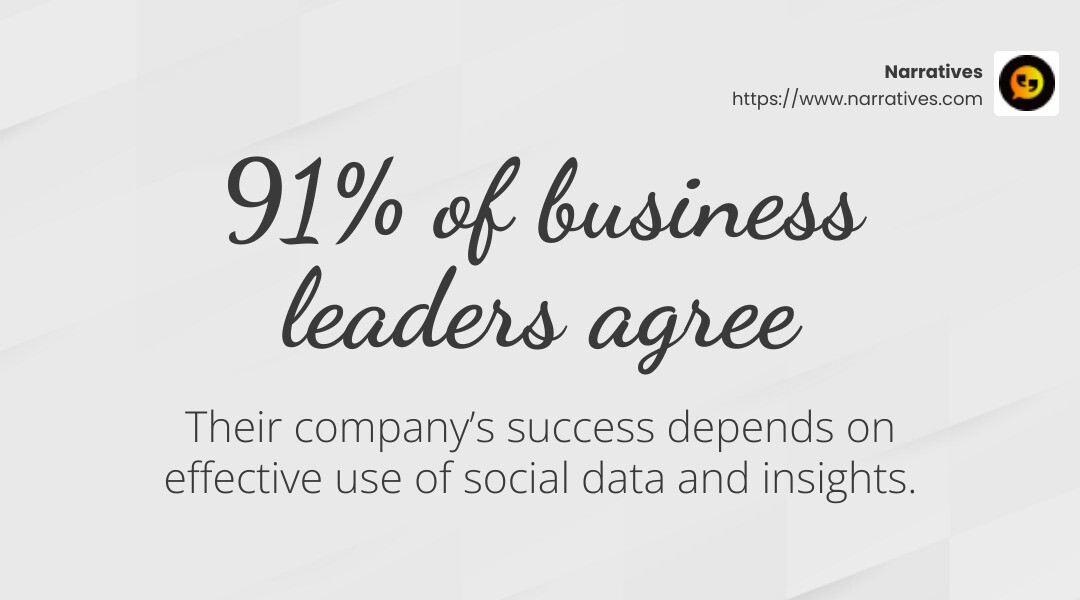Stay Alert: The Ultimate Guide to Social Media Monitoring Systems

Social media monitoring system is a powerful tool for organizations wanting to amplify their mission and make an impact. Whether you're working in a non-profit or managing an advocacy-focused brand, these systems can transform how you engage with your audience. Here's why they matter:
- Track Engagement: Monitor likes, comments, shares, and more to see what resonates.
- Inform Strategy: Use insights to adjust your messaging and improve outreach campaigns.
- Manage Reputation: Spot negative feedback early and address it effectively.
- Gain Competitive Edge: Stay ahead by understanding industry trends and competitor activities.
In today's digital landscape, staying alert and informed through social media monitoring is more crucial than ever. An effective system does more than just track mentions—it reveals insights that can shape your storytelling and strategy.
For those seeking to foster strong community connections and drive social impact, integrating a robust social media monitoring system can open up new opportunities. As highlighted by the 2023 State of Social Media Report, 91% of leaders agree that leveraging social data is key to success.
Consider how this fits into your larger narrative. Engaging stories backed by data can drive both awareness and action, supporting your mission effectively.

Social media monitoring system word list:
What is a Social Media Monitoring System?
A social media monitoring system is a tool that helps track and analyze interactions across various social media platforms. These systems are designed to capture every like, comment, share, and mention related to your brand or cause, providing a comprehensive view of your online presence.
Tracking Beyond Mentions
While track direct mentions of your brand, a robust monitoring system goes further. It scans for relevant hashtags, keywords, and even competitor mentions. This broad tracking capability ensures you don't miss out on conversations that could be crucial for your strategy. For instance, if someone asks for product recommendations in your industry, your system can alert you, allowing you to engage proactively.
Boosting Engagement
Engagement is the heart of social media success. By understanding what content resonates with your audience, you can tailor your posts to maximize interaction. A monitoring system provides insights into which posts generate the most buzz, helping you refine your content strategy. This data-driven approach can significantly improve your brand visibility and foster a more engaged community.
Real-Time Insights
The real-time nature of these systems means you're always in the loop. Whether it's a sudden spike in mentions or a viral trend relevant to your cause, you'll know about it as it happens. This immediacy allows for timely responses, whether you're thanking a supporter or addressing a concern.
In the world of social media, staying informed is crucial. A social media monitoring system equips you with the tools to not only track but also engage effectively, ensuring your brand remains relevant and impactful.

Incorporating these systems can transform your approach to digital engagement, offering a strategic advantage in building strong community ties and achieving your mission.
Top 10 Social Media Monitoring Systems for 2025
Selecting the right social media monitoring system can be a game-changer for your brand's online presence. Here, we explore the top 10 systems that are leading the way in 2025, each offering unique features to help you stay ahead in the social media landscape.
1. Sprout Social
Sprout Social is a powerhouse for those seeking both management and monitoring capabilities. Its standout feature, the Smart Inbox, consolidates messages, mentions, and tags from all major platforms into one convenient hub. This tool is perfect for small to medium enterprises (SMEs) looking to streamline their social interactions and gain valuable insights through its Trend Reports.
2. Meltwater
Meltwater excels in providing deep insights through its robust data analytics. It's an ideal choice for brands wanting to dive into competitive analysis and measure ROI effectively. Meltwater's comprehensive media monitoring capabilities extend beyond social platforms to include news, blogs, and forums, offering a well-rounded view of your brand's digital footprint.
3. Hootsuite
Hootsuite is synonymous with social media management, but its monitoring features are equally impressive. With the easy-to-use Streams dashboard, you can track all your brand's mentions, comments, and tags across multiple platforms. Hootsuite is perfect for brands with moderate online activity, offering both basic and advanced monitoring tools.
4. HubSpot
HubSpot's social media tool integrates seamlessly with its CRM, providing a 360-degree view of your social interactions. The platform's keyword monitoring streams and Inbox Insights tool make it a strong contender for businesses aiming to improve customer engagement and sentiment analysis across various channels.
5. Mention
Mention is known for its simplicity and effectiveness, making it a great option for small to medium brands. It offers real-time searches for brand mentions and provides Pulse alerts for sudden spikes in activity. This tool helps brands stay on top of conversations and manage reputation with ease.
6. Agorapulse
Agorapulse combines management and monitoring features effortlessly. Its Social Inbox allows for easy responding to comments and mentions, while its influencer outreach dashboard helps you identify and engage with key players in your industry. Agorapulse is ideal for brands looking to boost their content strategy with actionable insights.
7. Brand24
Brand24 is a go-to for brands focusing on reputation management. It provides real-time alerts on brand mentions and sentiment analysis, enabling you to respond promptly to any changes in public perception. This tool is particularly useful for brands aiming to maintain a positive image and manage crises effectively.
8. Talkwalker
Talkwalker stands out with its powerful analytics and ability to monitor a wide range of media sources. It's designed for brands that want to conduct in-depth competitive analysis and track global trends. Talkwalker's visual dashboards make it easy to interpret complex data and derive actionable insights.
9. Cyfe
Cyfe offers a unique approach by centralizing insights from various data sources into customizable dashboards. While it emphasizes visualization over interaction, it's an excellent choice for brands wanting a comprehensive view of their media activity, including mentions, keywords, and likes.
10. Statusbrew
Statusbrew is custom for teams working across sales, marketing, and customer care. It provides robust campaign management and analytics features, along with popular integrations like Slack and Shopify. Statusbrew is ideal for brands looking to improve collaboration and track overall brand health.
These social media monitoring systems each offer distinct advantages, catering to different needs and business sizes. By choosing the right system, you can gain a strategic edge in managing your brand's online presence and engaging more effectively with your audience.
Benefits of Using a Social Media Monitoring System
Maximize ROI
A social media monitoring system is your secret weapon for squeezing the most out of your marketing budget. By analyzing data from your posts, you can identify what content resonates with your audience. This helps you craft more engaging posts that boost brand visibility and sales.
For instance, by understanding which posts receive the most likes and shares, you can tailor future campaigns to hit the sweet spot with your audience. In turn, this lifts your social media ROI by ensuring your efforts are targeted and effective.
Reputation Management
In the world of social media, your brand's reputation can change in the blink of an eye. A social media monitoring system helps you keep tabs on what people are saying about you. With real-time alerts, you can catch negative comments or reviews early, allowing you to address issues before they escalate.
According to the State of Social Media Report, 90% of business leaders agree that social insights are crucial for managing crises and crafting effective PR strategies. By staying proactive, you can maintain a positive brand image and build trust with your audience.
Competitive Analysis
Keeping an eye on your competitors is just as important as monitoring your own brand. A social media monitoring system allows you to track your competitors' campaigns, engagement rates, and customer sentiment.
By analyzing this data, you can set realistic benchmarks for your performance and uncover opportunities to differentiate yourself. For example, if your competitor's campaign is getting more traction, you can study their strategy and adapt your own to fill any gaps in the market.
Customer Insights
Understanding your customers' needs and preferences is the key to building a successful brand. A social media monitoring system provides valuable insights into customer behavior and sentiment. By tracking mentions and keywords, you can gain a deeper understanding of what your customers want and how they perceive your brand.
This information is invaluable for tailoring your products and services to meet customer expectations. When you know what your audience is looking for, you can create more meaningful connections and foster long-term loyalty.
By leveraging these benefits, a social media monitoring system becomes an indispensable tool for any brand looking to thrive in the digital age. Up next, we'll explore how to choose the right system for your needs.
Social Media Monitoring vs. Social Listening
When it comes to understanding the digital chatter around your brand, both social media monitoring and social listening play crucial roles. But what's the difference, and why do you need both?
Zoomed-In vs. Zoomed-Out
Think of social media monitoring as a zoomed-in approach. It's about keeping a close eye on the day-to-day conversations happening online. You're tracking mentions, comments, and direct messages. It's like being at a party and listening to each conversation about your brand, ready to jump in when necessary.
In contrast, social listening is your zoomed-out strategy. It involves gathering all those conversations and analyzing them for larger patterns and trends. Imagine stepping back from the party, observing the crowd, and understanding the overall vibe. This broader view helps you see how people feel about your brand over time and across different platforms.
Strategic Insights
While monitoring is about immediate reactions—like responding to a tweet or addressing a complaint—listening provides strategic insights. It helps you understand the sentiment behind the chatter. Are people generally positive about your new product? Do they have recurring complaints?
For instance, a restaurant might monitor social media to see how often their new burger is mentioned. But through listening, they find that customers love the taste but find the price too high. This insight allows the restaurant to adjust its pricing strategy or offer promotions.
Why Both Matter
Both approaches are essential. Monitoring keeps you grounded in the present, allowing for real-time engagement. Listening, however, prepares you for the future. It empowers you to make informed decisions based on comprehensive data.
Warren Talbot, Marketing Manager at Vans, highlights the importance of using the right tools for both monitoring and listening. With the right technology, you can "justify strategic business decisions" and lead meaningful discussions at the C-suite level.
By integrating both social media monitoring and social listening, you can handle immediate concerns while also crafting long-term strategies. Up next, we'll dive into how to choose the right system for your business.
How to Choose the Right Social Media Monitoring System
Selecting the right social media monitoring system can be a game-changer for your business. But with so many options out there, how do you make the right choice? Let's break it down into key factors: features, scalability, integration, and user-friendliness.
Features
When choosing a system, start by looking at the features. Real-time tracking is essential. You want to know what's being said about your brand the moment it happens. Sentiment analysis is another must-have. It helps you understand the emotions behind the mentions—are they positive or negative?
Other features to consider include influencer identification and customizable reports. These tools can help you identify key players in your industry and tailor data insights to your needs.
Scalability
Whether you're a small business or a growing enterprise, scalability is crucial. Your monitoring system should grow with you. Look for platforms that offer flexible pricing plans and can handle increased data as your business expands.
For example, a startup might start with basic monitoring features. As it grows, it might need more advanced analytics and reporting capabilities. A scalable system ensures you don't outgrow your tools.
Integration
Seamless integration with your existing software is vital. You want a system that works well with your current CRM, email marketing, and project management tools. This ensures a smooth workflow and prevents data silos.
For instance, if you're using HubSpot as your CRM, consider a monitoring tool that integrates directly with it. This allows you to connect social interactions with customer data, providing a holistic view of your marketing efforts.
User-Friendliness
Finally, consider the user-friendliness of the platform. An intuitive interface makes onboarding easier and reduces training time. Look for systems with easy-to-steer dashboards and clear visualizations.
A user-friendly system means your team can focus on analyzing data and making strategic decisions, rather than getting bogged down by complex software. As Warren Talbot from Vans notes, the right technology should empower your team to "justify strategic business decisions" without unnecessary hassle.
By focusing on features, scalability, integration, and user-friendliness, you can choose a social media monitoring system that fits your needs and helps your business thrive.
Next, let's tackle some frequently asked questions about these systems to further guide your decision-making process.
Frequently Asked Questions about Social Media Monitoring Systems
What are the key features to look for?
When you're on the hunt for a social media monitoring system, certain features stand out as essential. Real-time tracking tops the list. This feature allows you to see mentions of your brand as they happen, enabling you to react promptly. Another vital feature is sentiment analysis. This tool helps you gauge the mood behind social interactions—whether they're positive or negative—so you can adjust your strategy accordingly.
In addition to these, consider features like influencer identification and customizable reports. These can help you pinpoint key figures in your industry and tailor insights to your specific needs.

How do these systems help in crisis management?
A good monitoring system can be a lifesaver when it comes to crisis management. The power of early detection cannot be overstated. By identifying potential issues as they arise, you can take a proactive response rather than a reactive one. For instance, if negative comments start trending, you can address them before they spiral into a full-blown PR crisis.
This proactive approach not only helps in managing the situation but also demonstrates to your audience that you're attentive and responsive. According to the State of Social Media Report, 9 out of 10 business leaders find social media insights crucial for managing crises effectively.
Can small businesses benefit from these systems?
Absolutely! Even small businesses can reap the benefits of a social media monitoring system. Many tools offer cost-effective options that fit smaller budgets without compromising on essential features. Scalability is another advantage. As your business grows, your monitoring system can expand with you, offering more advanced features as needed.
For small businesses, these systems provide valuable insights into customer preferences and industry trends. This data can guide your marketing efforts, helping you make informed decisions that boost engagement and sales.
In summary, whether you're a small startup or a large corporation, the right social media monitoring tools can offer significant advantages, from real-time tracking and sentiment analysis to crisis management and scalable solutions.
Conclusion
As we wrap up our exploration of social media monitoring systems, it's clear that these tools are indispensable for any organization aiming to stay ahead in the digital landscape. At Narratives, we understand the power of storytelling and the impact it can have on communities, especially for non-profits and purpose-driven organizations.
Narratives is committed to elevating underrepresented voices through high-quality, emotionally resonant content. Our focus is on helping non-profits share their impact stories in a way that inspires action, builds trust, and increases visibility. By leveraging social media monitoring tools, we can amplify these stories, ensuring they reach the right audiences and create meaningful change.
Community impact is at the heart of what we do. Social media monitoring allows us to track the conversations that matter, engage with communities effectively, and adapt our strategies to better serve them. This is not just about gathering data; it's about understanding and responding to the needs of the communities we aim to uplift.
In the changing world of digital communication, staying alert and informed is crucial. By choosing the right social media monitoring system, you can harness the power of real-time insights, sentiment analysis, and strategic engagement to drive your mission forward.
For more on how Narratives can support your storytelling needs and amplify your impact, visit our media services page. Let's work together to create stories that resonate and inspire action.


